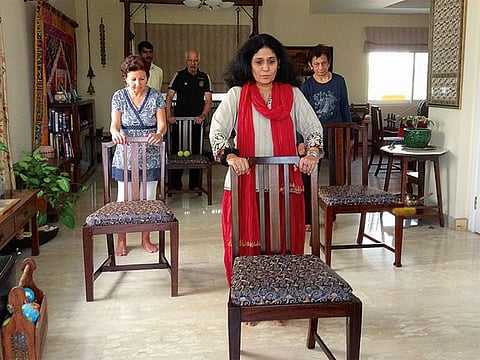Watch: Indian expat in Dubai helps empower Parkinson's patients
'Movement Mantra' gets patients to fight mobility challenges through dance, yoga

Dubai: An Indian expat from Dubai is advocating a ‘Movement Mantra’ for those diagnosed with Parkinson’s disease.
As April comes to a close – a month dedicated to Parkinson’s Disease, Dr. Vonita Singh, a Kathak dance exponent and life coach working with people suffering from Parkinson’s, said, “I lost my father to Parkinson’s Disease (PD) in 2009. Personally, I have suffered with Arthritis since I was a teenager. These personal challenges coupled with my own interest to help individuals who are differently abled, made me start the Movement Mantra.”
What is Parkinson’s disease?
“Parkinson’s disease is a slowly progressive neurological disease caused by degeneration or death of brain cells (neurons) making a chemical called dopamine in a specific area of brain. Low concentrations of dopamine prevent the transmission of nerve impulses and the brain cannot carry signals in the proper way. Therefore, there is a loss of connection between the brain and other body parts. A loss of dopamine results in the loss of control of body movements,” explained Dr. Ravi Shanker Lohano, Specialist Neurologist, Saudi German Hospital, Ajman.

Movement Mantra
A certified yoga instructor, Dr. Vonita said Movement Mantra is intended to enforce movement and exercise through dance and yoga as a rule or “mantra” in the lives of Parkinson’s patients. “We help individuals not only overcome their mobility challenges but also achieve emotional, cognitive, physical and social integration with dance and yoga.”
“The Movement Mantra started off as dance sessions with one Parkinson’s Disease ‘hero’ in 2013. It has organically grown to include many more and over time, has become a platform to bring together people with the disease and their families.”
Patient-speak
Two Parkinson’s patients Mahmood Merchant and Milind Joshi shared their experiences with Gulf News and vouched for the benefits of staying active.
Their better halves Neeta Merchant and Aparna Joshi, also stressed the role of caregivers in managing Parkinson’s patients.
A chartered accountant by profession who worked as a finance director for a private firm in Dubai, Merchant said when he faced the initial symptoms of tremors in his left hand and left leg and the following diagnosis that he had Parkinson’s, it did come as a blow. “But with awareness and great support by my caregiver, my wife, I am in the journey with more confidence. We have also discovered the Movement Mantra by Dr. Vonita that is helping us immensely to get through the daily life of living with Parkinson’s.”
His wife Neeta said: “As for the caregiver, the one looking after a person with the disease has to be disciplined, be mentally and physically strong.”
Joshi, a business professional, recalled being hospitalised and unable to move his limbs or even shut his eye-lids. “I was in the early stages of my Parkinson’s diagnosis. It was a time when I was trying to fight the disease by looking at alternative treatment and therapy. It just left me in a hospital. That was the time I realised medication and exercise are two essentials for a Parkinson’s patient.”
His wife Aparna said it was also the time she came across Dr. Vonita and her Movement Mantra that ensured her husband was back on track and out of the hospital bed. “Today, he is able to walk, talk and also drive. With regular medication and exercise, we are seeing a huge improvement.”
Merchant said Movement Mantra brings people with the same issue together, “I felt I was meeting and talking to people who understood me and my condition. I met people similar to me. It felt really good.”
Joshi added: “We meet twice a week, sometimes thrice. Dr. Vonita arranges a number of sessions for us to dance, move, sing, so we exercise our muscles. Just like students memorising their school work and practising it again and again to get it right, we exercise and move to practise our muscles to function normally. This helps our bodies from becoming rigid.”
What causes Parkinson’s disease?
Experts do not know why Parkinson’s disease develops, but it is believed to result from an interplay of genetic changes and exposure to environmental factors such as toxins. This disease affects men more than women. One clear risk is age. Although most people with Parkinson’s first develop the disease after age 60, about five-10 per cent experience its onset before the age of 50. Early onset forms of Parkinson’s are often, but not always, inherited, and some forms have been linked to specific alterations in genes.
How is Parkinson’s diagnosed, treated?
There are currently no blood or laboratory tests to diagnose non-genetic cases of Parkinson’s disease. Doctors usually diagnose the disease by taking a person’s medical history and performing a neurological examination. If symptoms improve after starting the medication used to treat the disease, it’s another indicator that the person has the disease.
There is no cure either for Parkinson’s disease but treatments including medications, lifestyle adjustments, surgery in some cases. Supportive therapies like physiotherapy, occupational therapy, speech and language therapy, dietary changes also help.
Sign up for the Daily Briefing
Get the latest news and updates straight to your inbox



